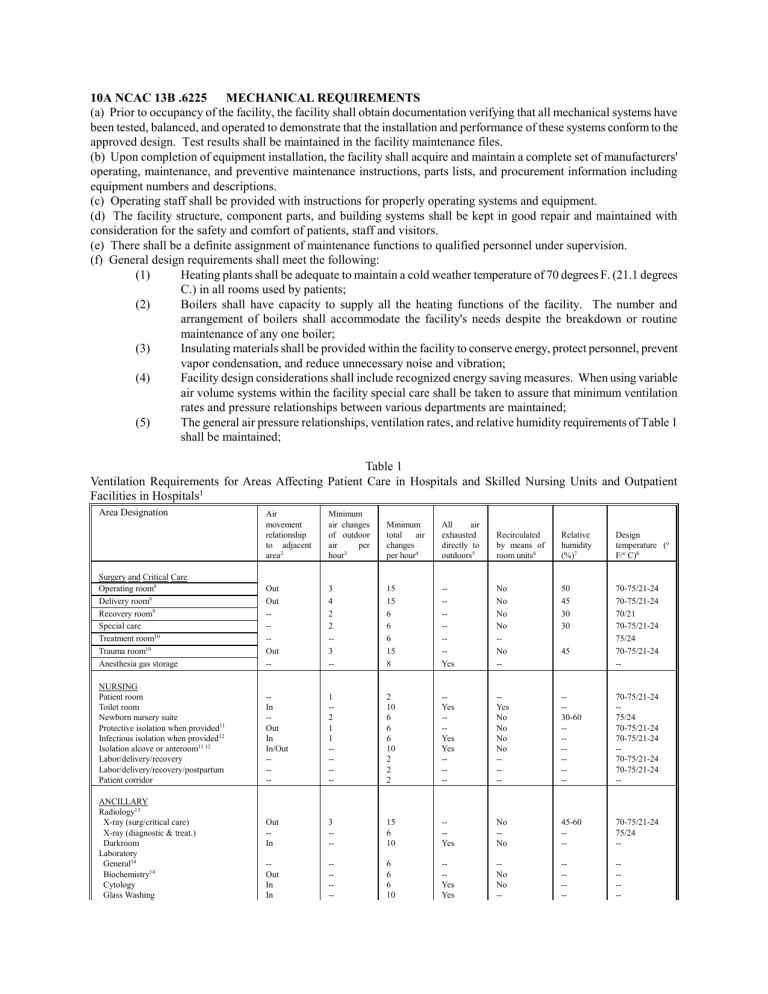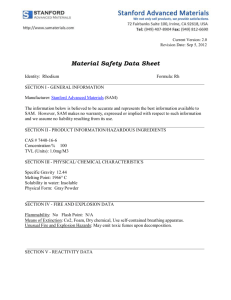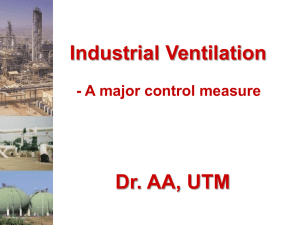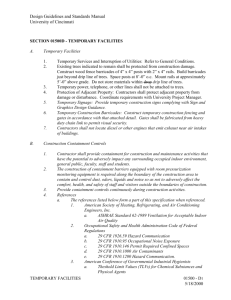10A NCAC 13B .6225 MECHANICAL REQUIREMENTS (a) Prior to

10A NCAC 13B .6225 MECHANICAL REQUIREMENTS
(a) Prior to occupancy of the facility, the facility shall obtain documentation verifying that all mechanical systems have been tested, balanced, and operated to demonstrate that the installation and performance of these systems conform to the approved design. Test results shall be maintained in the facility maintenance files.
(b) Upon completion of equipment installation, the facility shall acquire and maintain a complete set of manufacturers' operating, maintenance, and preventive maintenance instructions, parts lists, and procurement information including equipment numbers and descriptions.
(c) Operating staff shall be provided with instructions for properly operating systems and equipment.
(d) The facility structure, component parts, and building systems shall be kept in good repair and maintained with consideration for the safety and comfort of patients, staff and visitors.
(e) There shall be a definite assignment of maintenance functions to qualified personnel under supervision.
(f) General design requirements shall meet the following:
(1) Heating plants shall be adequate to maintain a cold weather temperature of 70 degrees F. (21.1 degrees
C.) in all rooms used by patients;
(2) Boilers shall have capacity to supply all the heating functions of the facility. The number and arrangement of boilers shall accommodate the facility's needs despite the breakdown or routine maintenance of any one boiler;
(3)
(4)
(5)
Insulating materials shall be provided within the facility to conserve energy, protect personnel, prevent vapor condensation, and reduce unnecessary noise and vibration;
Facility design considerations shall include recognized energy saving measures. When using variable air volume systems within the facility special care shall be taken to assure that minimum ventilation rates and pressure relationships between various departments are maintained;
The general air pressure relationships, ventilation rates, and relative humidity requirements of Table 1 shall be maintained;
Table 1
Ventilation Requirements for Areas Affecting Patient Care in Hospitals and Skilled Nursing Units and Outpatient
Facilities in Hospitals 1
Area Designation
Surgery and Critical Care
Operating room 9
Delivery room 9
Recovery room 9
Special care
Treatment room 10
Trauma room 10
Anesthesia gas storage
NURSING
Patient room
Toilet room
Newborn nursery suite
Protective isolation when provided 11
Infectious isolation when provided
12
Isolation alcove or anteroom 11 12
Labor/delivery/recovery
Labor/delivery/recovery/postpartum
Patient corridor
ANCILLARY
Radiology
13
X-ray (surg/critical care)
X-ray (diagnostic & treat.)
Darkroom
Laboratory
General
14
Biochemistry 14
Cytology
Glass Washing
Air movement relationship to adjacent area 2
Out
Out
--
--
--
Out
--
Out
--
In
--
Out
In
In
--
In
--
Out
In
In/Out
--
--
--
3
--
--
--
--
--
3
--
--
2
1
1
--
--
--
--
1
--
3
Minimum air changes of outdoor air hour 3 per
4
2
2
--
6
6
6
10
15
6
10
6
6
6
10
2
2
2
2
10
Minimum total air changes per hour 4
15
15
6
6
6
15
8
--
All air exhausted directly to outdoors 5
--
--
--
--
--
Yes
--
--
Yes
--
--
Yes
Yes
--
Yes
--
--
Yes
Yes
--
--
--
No
--
No
--
No
--
No
No
--
--
Yes
No
No
No
No
--
--
--
Recirculated by means of room units 6
No
No
No
No
--
30
45
--
--
--
--
45-60
--
--
--
--
30-60
--
--
--
--
--
--
Relative humidity
(%) 7
50
45
30
Design temperature ( o
F/ o C) 8
70-75/21-24
70-75/21-24
70/21
70-75/21-24
75/24
70-75/21-24
--
70-75/21-24
--
75/24
70-75/21-24
70-75/21-24
--
70-75/21-24
70-75/21-24
--
--
--
--
--
70-75/21-24
75/24
--
Area Designation
Histology
Microbiology 14
Nuclear medicine 13
Pathology
Serology
Sterilizing
Autopsy room
Non refrigerated body-holding room
15
Pharmacy
DIAGNOSTIC AND TREATMENT
Examination Room
Medication room
Treatment room
Physical therapy and hydrotherapy
Soiled workroom or soiled holding
Clean workroom or clean holding
STERILIZING AND SUPPLY
ETO-sterilizer room 16
Sterilizer equipment room
16
Central medical and surgical supply
Soiled or decontamination room
Clean workroom and sterile storage
SERVICE
Food preparation center 17
Warewashing
Dietary day storage
Laundry, general
Clean linen storage
Soiled linen (sorting and storage)
Soiled linen and trash chute room
Bedpan room
Bathroom
Janitor's closet
Air movement relationship to adjacent area 2
In
In
In
In
Out
In
In
In
--
--
--
--
In
In
--
In
In
Out
In
Out
--
In
In
--
In
--
In
In
--
In
Minimum air changes of outdoor air hour 3
--
--
--
--
--
--
--
--
--
--
--
--
--
--
--
--
--
--
--
--
--
--
--
--
--
--
--
--
-- per
6
6
10
4
6
4
10
10
6
4
6
10
10
2
10
10
2
10
10
10
10
6
6
6
6
6
10
12
10
4
Minimum total air changes per hour 4
All
Yes
Yes
Yes
Yes
--
Yes
Yes
Yes
--
--
--
--
--
Yes
--
Yes
Yes
--
Yes
--
--
Yes
--
Yes
Yes
--
Yes
Yes
--
Yes air exhausted directly to outdoors 5
Recirculated by means of room units 6
No
No
No
No
No
--
No
Yes
--
--
--
--
--
No
--
No
--
No
--
No
No
No
--
--
No
--
No
Yes
--
No
Relative humidity
(%) 7
--
--
--
--
--
--
--
--
--
--
--
--
--
--
--
--
--
--
--
(Max) 70
--
--
--
--
--
--
--
--
--
--
Design temperature ( o
F/ o C) 8
--
--
--
--
--
--
--
70/21
--
Table Notes:
1 The ventilation rates in this table cover ventilation for comfort, as well as for asepsis and odor control in areas of acute care hospitals that directly affect patient care and are determined based on health care facilities being predominantly "No Smoking" facilities. Where smoking may be allowed, ventilation rates will need adjustments.
Specialized patient care areas, including organ transplant units, burn units, specialty procedure rooms, etc., shall have additional ventilation provisions for air quality control as may be appropriate.
2 Design of the ventilation system shall provide that air movement is from "clean to less clean" areas. However, continuous compliance may be impractical with full utilization of some forms of variable air volume and load shedding systems that may be used for energy conversation. Areas that do require positive and continuous control are noted with "Out" or "In" to indicate the required direction of air movement in relation to the space named. Rate of air movement may be varied as needed within the limits required for positive control. Air movement for rooms with dashes and non-patient areas may vary as necessary to satisfy the requirements of those spaces. Additional adjustments may be needed when space is unused or unoccupied and air systems are de-energized or reduced.
3 To satisfy exhaust needs, replacement air from outside is necessary. Table 1 does not attempt to describe specific amounts of outside air to be supplied to individual spaces except for certain areas such as those listed. Distribution of the outside air, added to the system to balance required exhaust, shall be as required by good engineering practice.
4 Number of air changes may be reduced when the room is unoccupied if provisions are made to ensure that the number of air changes indicated is reestablished any time the space is being utilized. Adjustments shall include provisions so that the direction of air movement shall remain the same when the number of air changes is reduced.
Areas not indicated as having continuous directional control may have ventilation systems shut down when space is unoccupied and ventilation is not otherwise needed.
5 Air from areas with contamination and/or odor problems shall be exhausted to the outside and not recirculated to other areas. Note that individual circumstances may require special consideration for air exhaust to outside, e.g., in intensive care unit in which patients with pulmonary infection are treated, and rooms for burn patients.
6 Because of cleaning difficulty and potential for buildup of contamination, recirculating room units shall not be used in areas marked "No." Isolation and intensive care unit rooms may be ventilated by reheat induction units in which only the primary air supplied from a central system passes through the reheat unit. Gravity-type heating or cooling units such as radiators or connectors shall not be used in operating rooms and other special care areas.
7
8
The ranges listed are minimum and maximum limits where control is specifically needed.
Dual temperature indications (such as 70-75/21-24) are for an upper and lower variable range at which the room temperature shall be controlled. A single figure indicates a heating or cooling capacity of at least the indicated temperature. This is usually applicable when patients may be undressed and require a warmer environment.
Nothing in these rules shall be construed as precluding the use of temperatures lower than those noted when the patients' comfort and medical conditions make lower temperatures desirable. Unoccupied areas such as storage rooms shall have temperatures appropriate for the function intended.
9 For Information Only - National Institute of Occupational Safety and Health (NIOSH) Criteria Documents regarding Occupational Exposure to Waste Anesthetic
Gases and Vapors, and Control of Occupational Exposure to Nitrous Oxide indicate a need for both local exhaust (scavenging) systems and general ventilation of the areas in which the respective gases are utilized.
10 The term trauma room as used here is the operating room space in the emergency department or other trauma reception area that is used for emergency surgery.
The first aid room and/or "emergency room" used for initial treatment of accident victims may be ventilated as noted for the "treatment room."
75/24
--
75/24
75/24
--
--
75/24
--
--
--
75/24
--
--
--
--
--
--
--
--
75/24
--
11 The protective isolation rooms described in these rules are those that might be utilized for patients with a high susceptibility to infection from leukemia, burns, bone marrow transplant, or acquired immunodeficiency syndrome and that require special consideration for which air movement relationship to adjacent areas would be positive rather than negative. For protective isolation the patient room shall be positive to both anteroom and toilet. Anteroom shall be neutral to corridor. Where requirements for both infectious and protective isolation are reflected in the anticipated patient load, ventilation shall be modified as necessary. Variable supply air and exhaust systems that allow maximum isolation room space flexibility with reversible air movement direction would be acceptable only if appropriate adjustments can be ensured for different types of isolation occupancies. Control of the adjustments shall be under the supervision of the medical staff.
12 The infectious isolation rooms described in these rules are those that might be utilized in the average community hospital. The assumption is made that most isolation procedures will be for infectious patients and that the room is suitable for normal private patient use when not needed for isolation. This compromise obviously does not provide for ideal isolation. The design shall consider types and numbers of patients who might need this separation within the facility. Isolation room shall be negative to anteroom and positive to toilet. Anteroom shall be neutral to corridor.
13 Large hospitals may have separate departments for diagnostic and therapeutic radiology and nuclear medicine. For specific information on radiation precautions and handling of nuclear materials, refer to appropriate sections of requirements developed by the Division of Radiation Protection, NCDEHNR.
14
15
When required, appropriate hoods and exhaust devices for the removal of noxious gases shall be provided.
A non-refrigerated body-holding room would be applicable only for health care facilities in which autopsies are not performed on-site, or the space is used only for holding bodies for short periods prior to transferring.
16 For Information Only - Specific OSHA regulations regarding ethylene oxide (ETO) use have been promulgated. 29CRF Part 1910.1047 includes specific ventilation requirements including local exhaust of the ETO sterilizer area.
17 Food preparation centers shall have an excess air supply for "out" air movements when hoods are not in operation. The number of air changes may be reduced or varied to any extent required for odor control when the space is not in use.
(6) Air duct liners exposed to the air stream shall not be used in ducts serving special care areas or special procedure rooms when such liners are constructed with frangible materials that will enter the air
(7) stream;
All central ventilation or air conditioning systems shall be equipped with filters with efficiencies equal to, or greater than, those specified in Table 2. Where two filter beds are required, filter bed No. 1 shall be located upstream of the air conditioning equipment and filter bed No. 2 shall be downstream of any fan or blowers. A manometer shall be installed across each filter bed having a required efficiency of
75 percent or more;
Table 2
Filter Efficiencies for Central Ventilation and Air Conditioning Systems in General Hospitals
No. filter beds
2
Filter bed No. 1
25% o
Filter bed No. 2
90% o
Area Designation
All areas for inpatient care, treatment, and diagnosis, and those areas providing direct service or clean supplies such as sterile and clean processing, etc.
Protective isolation room when used
Laboratories
Administrative, bulk storage, soiled holding areas, food preparation areas, and laundries
2
1
1
25%
80%
25% o o o
99.7%
--
--
5
Table notes: Note 1 - Ratings based on ASHRAE 52-76
Note 2 - Rating based on DOP (Dioctyl-phthalate) test method
(8)
(9)
Any system utilized for occupied areas shall include provisions to avoid air stagnation in interior spaces where comfort demands are met by temperatures of surrounding areas;
All rooms and areas in the facility used for patient care shall have provisions for year round mechanical ventilation;
(10) Each patient's room shall have at least one openable window, opening to the outside to permit ventilation; and
(11) In psychiatric units, all convectors, HVAC enclosures, or air distribution devices that are exposed in the room shall be constructed with rounded corners and shall be fastened with tamper-proof screws.
(g) Mechanical air intakes shall meet the following:
(1) Air intakes shall be located not less than 30 feet (9.14 m.) from exhaust outlets of combustion equipment stacks, ventilation exhaust outlets from the facility or adjoining buildings, medical-surgical
(2) vacuum system exhausts or areas that may be subject to vehicular exhaust or other noxious fumes; and
The bottom of the outdoor air intakes shall be at least 6 feet (1.83 m.) above ground level, or if installed above the roof, at least 3 feet (.91 m.) above roof level.
(h) Mechanical air exhaust/ventilation systems shall meet the following:
(1) Fans serving exhaust duct systems shall be located at the discharge end of the duct and shall be readily accessible for servicing; and
(2) Exhaust outlets shall be located a minimum of 10 feet (3 m.) above ground and directed away from occupied areas, doors, or openable windows. Prevailing winds, adjacent buildings, and discharge velocities shall be taken into account when designing such outlets.
(i) Surgery and special care areas shall meet the following:
(1) All air shall be supplied at or near the ceiling and removed from at least two remote locations near the floor;
(2) Bottom of exhaust or return registers shall be no less than 3 inches (7.62 cm.) above the finished floor level; and
Exhaust grilles for anesthesia evacuation and other special applications shall be permitted to be (3) installed in the ceiling.
(j) Nursery, labor, delivery, recovery, postpartum, and invasive procedure rooms shall meet the following:
(1)
(2)
Air supply shall be at or near the ceiling. Return or exhaust air registers shall be near the floor;
Bottom of exhaust or return registers shall be no less than 3 inches (7.62 cm.) above the finished floor level; and
(3)
(1)
Exhaust grilles for anesthesia evacuation and other special applications shall be permitted to be installed in the ceiling.
(k) Isolation units shall meet the following:
Rooms for isolation of patients shall meet the ventilation requirements of Table 1 (See 10A NCAC
13B .6225);
(2)
(3)
A separate anteroom used as an air lock to minimize the potential for airborne particulates from the patients' area reaching adjacent areas shall be provided; and
Air supply shall be introduced at or near the ceiling, flowing past the patient, and exhausted or returned at the floor.
(l) Smoke control/evacuation system(s) shall meet the following:
(1) When an engineered smoke control/evacuation system is provided, the system shall incorporate a design of the air duct system(s) and controls to inhibit the migration of smoke from the fire zone to the
(2) required means of egress and refuge areas;
When an emergency manual control stop switch is provided to shut down supply, return, and exhaust fans, the switch shall be incorporated into the smoke control system in a manner that will not
(3)
(4)
(5) jeopardize the effectiveness or dependability of the smoke control/evacuation system;
Static pressure sensors, freeze-stats, or other operating controls shall not jeopardize the effectiveness of the smoke control system during emergency operation;
Where smoke dampers are required to be installed as part of a passive smoke control system, smoke dampers shall be installed in ducts that are capable of communicating smoke between floors; and
Smoke dampers shall have a maximum air leakage of 10 cubic feet per minute per square foot of damper opening when tested at one inch water gauge of duct pressure. Smoke dampers shall be failsafe to the emergency position. Dampers shall close upon activation of the fire alarm system unless a part of an engineered smoke control system.
(m) Laboratories shall meet the following:
(1) In new construction and renovation work, each hood used to process infectious or radioactive materials shall have a minimum face velocity of 150 feet per minute with static pressure operated dampers and audio-visual alarms to alert staff of ventilation system failure. Each hood shall also have filters with a
99.7 percent efficiency (based on the DOP, dioctyl-phthalate test method) in the exhaust stream, and
(2) be designed and equipped to permit the safe removal, disposal, and replacement of contaminated filters; and
Each installation shall have an exhaust fan located at the discharge end of the duct system to maintain a negative pressure in the exhaust duct.
(n) Where ethylene oxide is used, the following requirements shall be met:
(1) Equipment utilizing ethylene oxide shall be installed in accordance with equipment manufacturer's installation instructions; and
(2) An air flow sensing device shall be installed in the exhaust duct. The sensor shall activate a visible and audible signal to alert personnel of ventilation system failure.
History Note: Authority G.S. 131E-79;
Eff. January 1, 1996.





